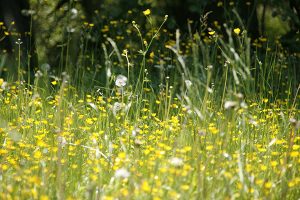Dr. Hamling on Seasonal Allergies
 Spring has arrived in Seattle! Birds are chirping, bugs are crawling, flowers are blooming, mold spores are floating…and for upward of 40 percent of children and their families, noses are running and eyes are tearing.
Spring has arrived in Seattle! Birds are chirping, bugs are crawling, flowers are blooming, mold spores are floating…and for upward of 40 percent of children and their families, noses are running and eyes are tearing.
Yes, it’s now prime time for symptoms of seasonal allergies, also known as hay fever or allergic rhinitis.
After spending a year working in Japan, which is known to have the highest concentration of seasonal-allergy sufferers, I, too, began to feel the effects of a scratchy throat, itchy eyes and intermittent cough.
Seasonal allergies are the result of the body’s immune system overreacting to allergens in our environment, such as pollens, molds, pet dander or dust mites. Once these allergens have made contact with the mucus membranes in our nose, eyes or mouth, the immune system releases a surge of antibodies and a protein called histamine. The body’s response to histamine is what is responsible for the symptoms of seasonal allergies.
As the weather gets warmer, children (and parents) want to spend more time outdoors, but it can be very frustrating for seasonal allergy sufferers. Any allergy sufferers who visited the University of Washington quad in the last couple weeks to see the cherry blossoms know exactly how this feels.
Simple solutions
Most health-care professionals diagnose seasonal allergies based on common symptoms and the time of the year that they occur. Symptoms can include a stuffy or runny nose, bouts of sneezing, itchy or watery eyes and occasionally a sore throat or cough.
Seasonal allergy symptoms can last six to eight weeks (usually beginning around early spring) and will self-resolve after the allergens in the environment have subsided. Once the spring pollen and ground molds have settled back into the ground, seasonal allergy symptoms usually dissipate quickly.
Symptoms may reoccur after a strong windstorm or if the patient is around freshly cut grass or tilled soil, as these processes tend to re-scatter pollen and mold spores.
If you believe you or your child suffers from seasonal allergies, the first line of defense is to try to avoid, block or filter those allergens that may trigger symptoms. Avoid playing or being outside during the early morning daylight hours, as this is prime time for newly dispersed pollen and mold spores. Instead, delay outdoor playtime until closer to lunch.
In addition, keep windows in your house closed at night, as open windows may introduce allergens while you sleep.
If you have a pet, consider that allergens may have latched onto your pet’s fur, so not sleeping in the same room with your pet may help to keep unwanted allergens away.
At home and in the car, you can use the air conditioner — not to cool the air but to send it through a filter.
Finally, daily showers or baths for you and your children will also help to rinse allergens off of skin and hair.
Medications
There are several medicinal treatments for children and adults who suffer from mild to moderate symptoms. The most common treatments start with over-the-counter anti-histamine medications such as Benadryl or Claritin. These drugs come in both liquid and pill forms and target the effects of your body’s histamine release.
Be sure to follow dosage instructions carefully, as dosages may differ for children and adults. Your provider can help you choose a medication that best meets your needs.
For those whose seasonal allergy symptoms are more moderate to severe, the next stage of treatment may include nasal steroid treatment. These medications, which help to reduce the overall inflammatory response, are available by prescription. Your pediatrician or family medicine physician can help you determine if this is an appropriate treatment for you or your child.
Allergy shots and other immunotherapy treatments are available for severe cases, but only after extensive testing and if avoidance of allergens and other treatments have failed. These treatments are not routinely recommended for young children.
A few simple home and environmental changes can provide a majority of relief for some suffers. If environmental changes do not provide relief from seasonal-allergy symptoms, then seeking medical attention may be the right course for you.
For myself this allergy season, I may follow the Japanese method: blocking pollens and allergens with a simple disposable surgical mask. While not yet popular in the United States, roughly 50 percent (or more) of Japanese people bring out their masks during spring allergy season.



